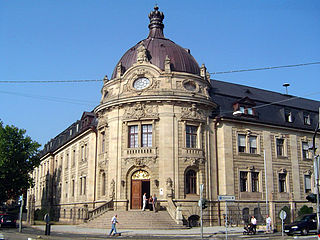
Pope Benedict V was Pope from 22 May to 23 June 964, in opposition to Pope Leo VIII. He was overthrown by emperor Otto I. His pontificate occurred at the end of a period known as the Saeculum obscurum.
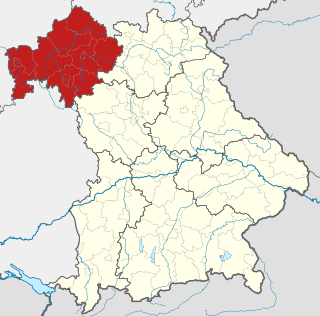
Lower Franconia is one of seven districts of Bavaria, Germany. The districts of Lower, Middle and Upper Franconia make up the region of Franconia.

Alfons Goppel was a German politician of the CSU party and Prime Minister of Bavaria (1962–1978).

Magdeburg Cathedral, officially called the Cathedral of Saints Catherine and Maurice, is a Protestant cathedral in Germany and the oldest Gothic cathedral in the country. It is the proto-cathedral of the former Prince-Archbishopric of Magdeburg. Today it is the principal church of the Evangelical Church in Central Germany. One of its steeples is 99.25 m tall, and the other is 100.98 m, making it one of the tallest cathedrals in eastern Germany. The cathedral is likewise the landmark of Magdeburg, the capital city of the Bundesland of Saxony-Anhalt, and is also home to the grave of Emperor Otto I the Great.

Christian Schad was a German painter associated with Dada and the New Objectivity movement. Considered as a group, Schad's portraits form an extraordinary record of life in Vienna and Berlin in the years following World War I.

Otto I was the Duke of Swabia from 973 and Duke of Bavaria from 976. He was a member of the Ottonian dynasty, the only son of Duke Liudolf of Swabia and his wife Ida, and thus a grandson of the Emperor Otto I and his Anglo-Saxon wife Eadgyth. His sister Mathilde was the abbess of Essen Abbey.
Alexander of Zweibrücken was Count Palatine and Duke of Zweibrücken and of Veldenz in 1489–1514.

Otto Piene was a German-American artist specializing in kinetic and technology-based art, often working collaboratively. He lived and worked in Düsseldorf, Germany; Cambridge, Massachusetts; and Groton, Massachusetts.

Johanna Friederike Charlotte Dorothea Eleonore, Princess of Bismarck, Duchess of Lauenburg was a Prussian noblewoman and the wife of the 1st Chancellor of Germany, Otto von Bismarck.
Flottenrichter Otto Heinrich Kranzbühler was a German naval judge who represented defendant Grand Admiral Karl Dönitz before the International Military Tribunal at the Nuremberg Trials.
Otto Pankok was a German painter, printmaker, and sculptor.

Georg Niedermeier is a German footballer who plays as a defender for Melbourne Victory FC.
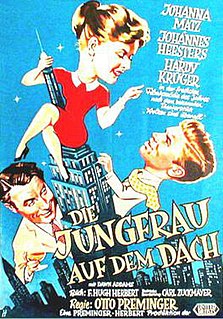
Die Jungfrau auf dem Dach is a 1953 American comedy film produced and directed by Otto Preminger. The screenplay by Carl Zuckmayer is a German language translation of the script for The Moon Is Blue by F. Hugh Herbert, based on his 1951 play.
Hermann Wilhelm Souchon was a German Navy officer who, according to the testimonies of two accomplices, executed Rosa Luxemburg on 15 January 1919 in Berlin.

Guido Dessauer was a German physicist, specialized in paper engineering, a business executive, writer, art collector, patron of arts, and academic. Born into a family of paper industrialists, he worked as an aerospace engineer during World War II and was an executive of the family's coloured paper factory in Aschaffenburg from 1945. He was an honorary citizen of Austria for saving 300 jobs in Styria in the 1960s. He earned a Ph.D. from the Graz University of Technology in his late 50s and became an honorary professor there. Interested in art, he collected bozzetti for 50 years and initiated the career of Horst Janssen as a lithographer.
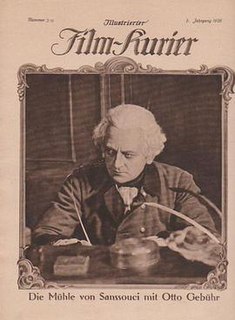
The Mill at Sanssouci is a 1926 German silent historical film directed by Siegfried Philippi and Frederic Zelnik and starring Otto Gebühr, Lissi Lind and Jakob Tiedtke. The film is part of the popular cycle of Prussian films. It premiered on 1 February 1926.
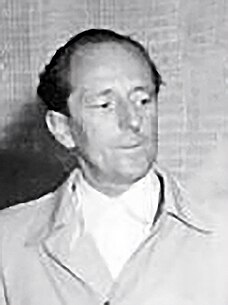
Walter Arnold was a German stonemason and sculptor. Between 1957 and 1964 he was the president of the Association of Visual Artists in East Germany.

The Kollegiatsstift St. Peter und Alexander is a Catholic church located in Aschaffenburg, Bavaria, Germany. It is the town's oldest church, established in the 10th century, dedicated to Saint Peter and Saint Alexander. The main building was built as a Roman basilica, other phases were built in the early Gothic style. The current structure is a cruciform basilica, reflecting a variety of styles including a Romanesque nave from the 12th century and a 15th-century tower.
Pelle flyttar till Komfusenbo is a 1990 Swedish film directed by Johanna Hald and based on the novel of the same name by Astrid Lindgren.



